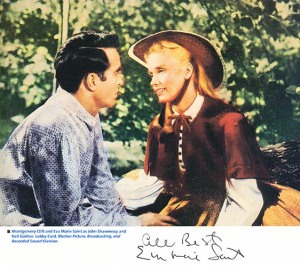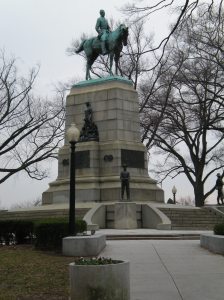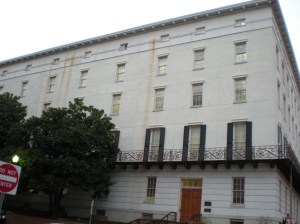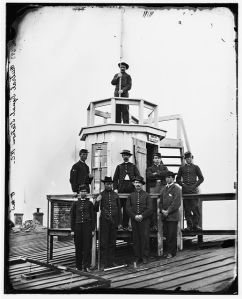A couple weeks ago my son received an invite to tour the White House, so on the spur of the moment we headed on down that way (see here). We didn’t have any time to visit with any friends, but we did manage to squeeze in some sightseeing. Click smaller images for great big giant ones. First up was the Blair House, across Pennsylvania Ave from the White House:

This was the home of publisher Francis Preston Blair, Sr., adviser to Presidents back to Andrew Jackson, and father of Montgomery (Lincoln’s Postmaster General) and Frank Jr. (Union Major General who commanded a corps under Sherman during the March to the Sea and Beyond). Frank Sr. was also the great-great-great grandfather of actor Montgomery Clift, who served in the Union Army in Raintree County:

The Clift-Blair relationship is murky – Clift’s mother claimed to be the illegitimate child of Montgomery’s son Woodbury, but it was never proven beyond a shadow. Photos show a strong resemblance between an older, beat-up Clift and Great-Grandpa Montgomery Blair. At least, I think so:


It was here in the Blair House that Colonel Robert E. Lee, prior to his resignation from the United States Army, was “felt out” for command of a Union army (not “the” army, as is commonly said, but as Lee himself said, the army that was to take the field – probably either Patterson’s or McDowell’s army) by Frank Sr.
Today, the complex of houses (four, I think) makes up the President’s guest house, used by visiting heads of state.
After that we took a walk around the White House…

…via the Treasury Building, behind which is this monument to Uncle Billy:

We took a long walk to the Mall and the Lincoln Memorial, which was the one place other than the White House my son wanted to see (there’s a good boy):

I’m always better for visiting the memorial. This time I had a nice conversation with the ranger on duty, while my wife and son were in the gift shop.
We returned to the White House via 17th St., and stopped briefly at F to take a picture of The Winder Building. Today the building serves as the headquarters of the United States Trade Representative (USTR). When it was built in 1848, at five stories it was the city’s first skyscraper. In 1854, it was purchased by the Federal government, and during the war served as the headquarters of Winfield Scott, Henry Halleck, the Quartermaster General, the Army Ordnance Department, and the Bureau of Military Justice. This is where the President lamented that “the bottom is out of the tub”, and where JAG Holt conducted the investigation into Lincoln’s assassination.

The Winder building plays a prominent role in the often used account of First Bull Run written fifty years after the battle by Peter Conover Hains, whose 30 pdr Parrott opened the fight. At the beginning of the Cosmopolitan Magazine article Hains recounted that his June, 1861 West Point class mustered into Federal service “in the old Wilder [sic] Building, opposite the war department” on June 25th, 1861. He wrote that there President Lincoln shook hands with each member of the class. I’ve been annotating the article – very, very slowly – and have found a number of problems with it, including this otherwise innoccuous episode. More on that later, but keep in mind that Cosmo published much of the writings of one Sally “LaSalle” Pickett. The army also had its central signal station on the roof of the building:

I’m hoping to get down to Washington in the spring or summer, and hope to have a few days to spend sightseeing and visiting friends and e-quaintances. So much to see, so little time.










Recent Comments